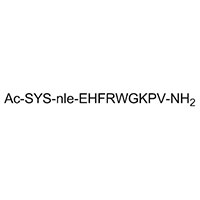Synonyms
Melanotan
Melanotan I
MFCD00151715
Wiskostatin
N-Acetyl-L-seryl-L-tyrosyl-L-seryl-L-norleucyl-L-α-glutamyl-L-histidyl-L-phenylalanyl-L-arginyl-L-tryptophylglycyl-L-lysyl-L-prolyl-L-valinamide
N-acetyl-L-seryl-L-tyrosyl-L-seryl-L-norleucyl-L-α-glutamyl-L-histidyl-L-phenylalanyl-N-(diaminomethylidene)-L-ornithyl-L-tryptophylglycyl-L-lysyl-L-prolyl-L-valinamide
N-acetyl-L-seryl-L-tyrosyl-L-seryl-L-norleucyl-L-α-glutamyl-L-histidyl-D-phenylalanyl-N-(diaminomethylidene)-L-ornithyl-L-tryptophylglycyl-L-lysyl-L-prolyl-L-valinamide
Ac-Ser-Tyr-Ser-Nle-Glu-His-DPhe-Arg-Trp-Gly-Lys-Pro-Val-NH2
L-Valinamide,
N-acetyl-L-seryl-L-tyrosyl-L-seryl-L-norleucyl-L-α-glutamyl-L-histidyl-L-phenylalanyl-
L-arginyl-L-tryptophylglycyl-L-lysyl-L-prolyl-
L-Valinamide,
N-acetyl-L-seryl-L-tyrosyl-L-seryl-L-norleucyl-L-α-glutamyl-L-histidyl-D-phenylalanyl-L-arginyl-L-tryptophylglycyl-L-lysyl-L-prolyl-
L-valinamide,
N-acetyl-L-seryl-L-tyrosyl-L-seryl-L-norleucyl-L-α-glutamyl-L-histidyl-D-phenylalanyl-N-(diaminomethylene)-L-ornithyl-L-tryptophylglycyl-L-lysyl-L-prolyl-
N-Acetyl-L-seryl-L-tyrosyl-L-seryl-L-norleucyl-L-α-glutamyl-L-histidyl-D-phenylalanyl-L-arginyl-L-tryptophylglycyl-L-lysyl-L-prolyl-L-valinamide
Scenesse
Ac-SYS-Nle-EHfRWGKPV-NH2
Afamelanotide
Product Description
Introduction:
Melanotropin is a significant chemical compound with various applications in the chemical industry. This
product introduction aims to provide an overview of Melanotropin, covering its raw materials, production
process, market trends, and the current status of amino acids in the industry.
Raw Materials:
Melanotropin is synthesized using amino acids as the primary raw materials. Specific amino acids, such
as L-phenylalanine, L-tyrosine, and L-cysteine, serve as precursors for the synthesis of
Melanotropin.
Production Process:
The production process of Melanotropin involves the following steps:
Step 1: Peptide Synthesis - Amino acids are selectively combined and chemically modified to form the
desired peptide structure of Melanotropin. This process may include solid-phase peptide synthesis,
liquid-phase peptide synthesis, or recombinant DNA technology.
Step 2: Purification - The synthesized Melanotropin is purified using techniques such as chromatography,
filtration, or crystallization to obtain the desired level of purity and remove any impurities or
by-products.
Market Trends:
The market demand for Melanotropin has been growing due to its various applications across industries.
Here are some key market trends:
Pharmaceuticals: Melanotropin has significant applications in the pharmaceutical industry, particularly
in dermatology. It is used for the treatment of certain skin conditions, such as vitiligo and
erythropoietic protoporphyria. Melanotropin works by stimulating melanocytes to produce melanin, which
helps in skin pigmentation.
Cosmetics: Melanotropin is also utilized in cosmetic formulations, primarily in sunless tanning products
and skin-darkening agents. It provides a natural-looking tan by stimulating melanin production without
the need for UV exposure.
Current Status of Amino Acids:
Amino acids are fundamental building blocks of peptides and proteins. They are essential in various
industries, including pharmaceuticals, cosmetics, and biotechnology. Amino acids serve as precursors for
the synthesis of Melanotropin and contribute to the advancement of peptide-based products.
Conclusion:
Melanotropin, synthesized using amino acids as raw materials, plays a significant role in the chemical
industry. Its production involves peptide synthesis and subsequent purification. The market demand for
Melanotropin is driven by its applications in pharmaceuticals and cosmetics. Amino acids continue to be
crucial components in various industries, contributing to the development of peptide-based products and
advancements in skin health and care.





